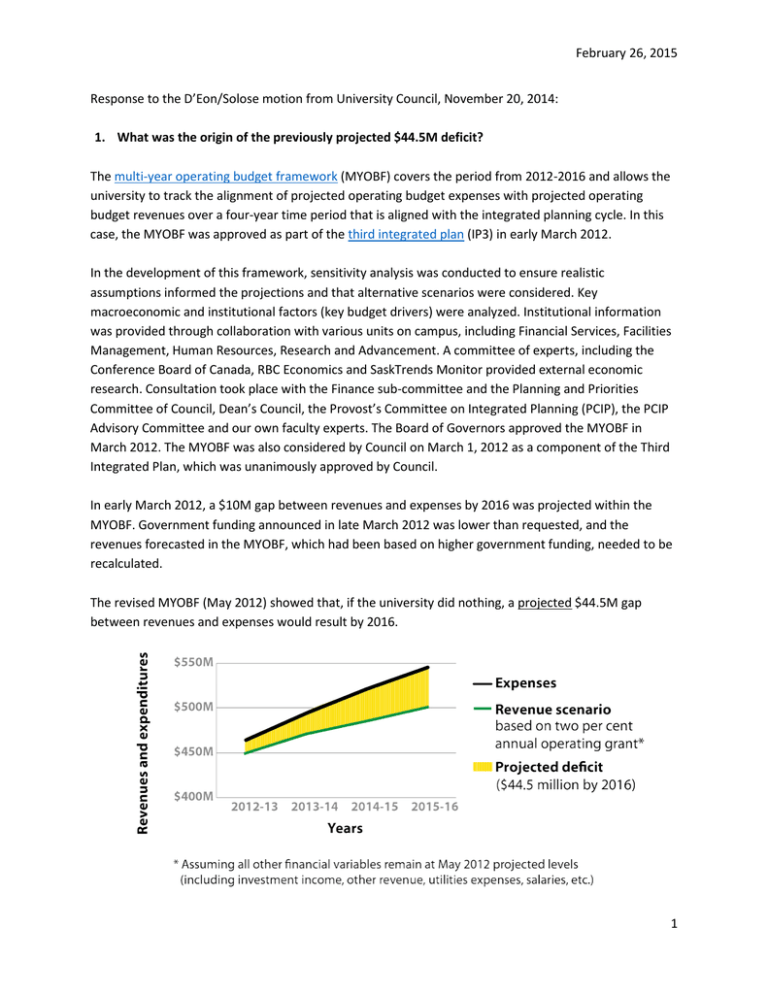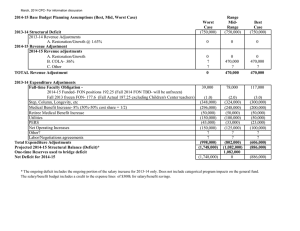February 26, 2015 e
advertisement

February 26, 2015 Response to the D’Eon/Solose motion from University Council, November 20, 2014: 1. What was the origin of the previously projected $44.5M deficit? The multi-year operating budget framework (MYOBF) covers the period from 2012-2016 and allows the university to track the alignment of projected operating budget expenses with projected operating budget revenues over a four-year time period that is aligned with the integrated planning cycle. In this case, the MYOBF was approved as part of the third integrated plan (IP3) in early March 2012. In the development of this framework, sensitivity analysis was conducted to ensure realistic assumptions informed the projections and that alternative scenarios were considered. Key macroeconomic and institutional factors (key budget drivers) were analyzed. Institutional information was provided through collaboration with various units on campus, including Financial Services, Facilities Management, Human Resources, Research and Advancement. A committee of experts, including the Conference Board of Canada, RBC Economics and SaskTrends Monitor provided external economic research. Consultation took place with the Finance sub-committee and the Planning and Priorities Committee of Council, Dean’s Council, the Provost’s Committee on Integrated Planning (PCIP), the PCIP Advisory Committee and our own faculty experts. The Board of Governors approved the MYOBF in March 2012. The MYOBF was also considered by Council on March 1, 2012 as a component of the Third Integrated Plan, which was unanimously approved by Council. In early March 2012, a $10M gap between revenues and expenses by 2016 was projected within the MYOBF. Government funding announced in late March 2012 was lower than requested, and the revenues forecasted in the MYOBF, which had been based on higher government funding, needed to be recalculated. The revised MYOBF (May 2012) showed that, if the university did nothing, a projected $44.5M gap between revenues and expenses would result by 2016. 1 February 26, 2015 This $44.5M projection was based on the best available information at the time, and eliminating it became a target to work towards. A plan was created to reduce this projected deficit by 2016, recognizing that actions in a university setting can require a significant one-time investment and months, or even years, before resulting in ongoing financial savings. While adjustments were underway, savings and reserves were increasing due to our fund allocation process. Funding from the central operating budget is allocated to colleges and units annually. Once this happens, the funds are spent at the discretion of the college/unit, and the funds allocation process is generally one way (i.e. surplus funds are not recovered centrally). There was one exception to this. In 2012, in consultation and co-ordination with colleges/units, $20M was returned to a central fund from the college/unit funds to use for transition funding. This funding was secured to assist with budget adjustment initiatives. Current practice allows colleges/units to keep annual surpluses as reserves and savings, and to spend these at their discretion. When colleges were informed of the projected deficit back in 2012-13, many of them reduced spending and began building reserves and savings due to concerns about future budget reductions. Colleges and schools generally held off from filling vacancies, launching new programs, discretionary spending and spending on special projects. As of April 30, 2014, the university’s general reserves (central and distributed throughout colleges and units) totalled $98M, while general savings (central and distributed) totalled $211M for a total savings and reserves of $309M. Of this total $309M in savings and reserves, risk reserves are $62M (20 per cent), academic priority funds are $36M (12 per cent), accountable professional expense fund (APEF) and deans' and senior administrators' expenses (DSAE) are $9M (3 per cent) and specific projects are $202M (65 per cent). There is a fund balance policy/guideline currently under development to ensure there are defined guidelines regarding reserve/savings funds and ongoing spending on university priorities moving forward. 2 February 26, 2015 2. What is the present actual deficits and the future projected deficits? Actions taken to date have resulted in a $37M narrowing of the gap projected in 2012: Additional effects (pension, LTD, travel, supplies, etc.) 40.0 35.0 5.0 Million dollars 30.0 25.0 20.0 9.8 7.6 15.0 10.0 5.0 Workforce planning Net faculty incentive plan for retirement (gross savings of $12.4M in 15/16) Changes in investment strategy 6.6 8.0 Changes in institutional practice (nonsalary, 2 up 1 down, other) 0.0 The university has not realized an actual deficit in past years. Although deficits were initially budgeted in the central operating budget for in 2009-10, 2012-13 and 2013-14, actions taken throughout each year ensured the budget was balanced before year-end. In 2013-14, the approved central operating budget projected a $3.3M deficit. However, revenues from investment returns were significantly higher than expected. This, together with higher than budgeted workforce planning savings and reduced utility costs, eliminated the budgeted deficit by year-end and led to a $21.1M surplus. Allocations from the year-end surplus were made to existing institutional commitments (e.g. one-time payments for the faculty incentive plan for retirement). The central operating budget has budgeted deficits of $3.1M for 2014-15 and $7.1M for 2015-16. The university will continue to seek additional revenue sources and prudently manage spending and allocations to ensure these deficits are not realized. Looking ahead to the future, revenue is still projected to continue to grow at a slower pace than expenses. 3 February 26, 2015 It is important to note had the university not taken the actions described above, a significant deficit would have come to fruition. The above graph demonstrates how expenses and revenues would have grown had the actions, which resulted in a combined $37M shift in revenues and expenses, not occurred. To summarize, the university has succeeded in lowering expenses since 2012-13 and allocates any yearend surplus funds for strategic allocations to existing commitments. 4 February 26, 2015 3. How and why the $44.5M projected deficit was adjusted to reflect the actual and future projected deficits? The $44.5M became a target that was based on best estimates at the time (May 2012). Based on actions taken in 2012-13 and 2013-14, that gap has been reduced by about $37M. Progress against the target was reported as it was made (sample slides from June 2013 town hall presentation and June 2014 financial presentation to Council are included below) and these adjustments were incorporated into future budgets. June 2013 town hall: what do projections tell us about the future? June 2014 University Council financial presentation: progress against $44.5M target (in 15-16 dollars) Distance to target 50.0 45.0 Million dollars 40.0 35.0 30.0 25.0 20.0 15.0 Workforce planning 12.5 9.8 7.6 10.0 6.6 5.0 8.0 0.0 Net faculty incentive plan for retirement (gross savings of $12.4M in 15/16) Changes in investment strategy Changes in institutional practice (non-salary, 2 up 1 down, other) 5





